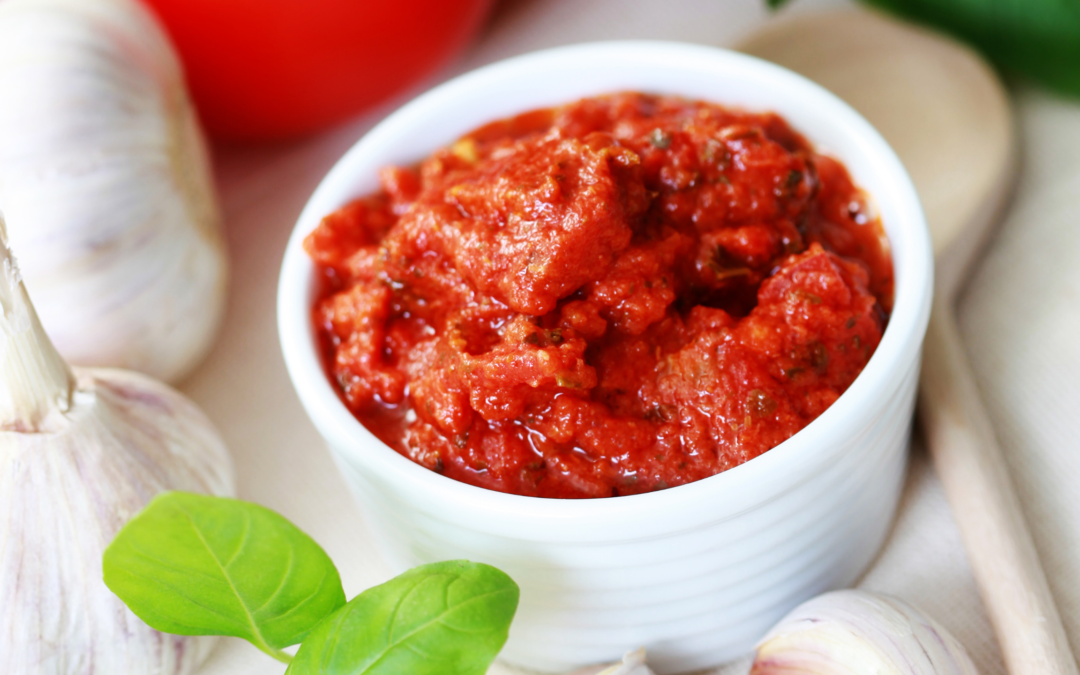
by Tomato Wellness | Nov 22, 2021 | Media Recipe
Looking for a filling, plant-based meal to switch things up? This walnut and mushroom ragu is sure to impress you and your family! Filled with flavor and bursting with nutrition, this recipe is one that you will turn to again and again. Plus, it’s easy to whip up, as you can get it on the table in under an hour.
Pasta dishes, like this one, are great ways to utilize vegetables, canned tomatoes, and other add-ins. For example, walnuts and cremini mushrooms are both great plant-based ingredients to use when bumping up the hardiness factor of a dish. They are easy to add, and enhance both the flavor and nutriton content to keep you full and satisfied. Additionally, these ingredients add a fun textural element to your pasta dish, which provides a different spin on a family favorite.
This recipe also includes canned tomatoes, which are a great source of vitamin C, fiber, potassium, and lycopene, an antioxidant with anti-inflammatory and anti-cancer properties. Plus, canned tomatoes actually have a higher lycopene content than fresh, as the cooking and canning process enhances the availability of the nutrient, making it easier for your body to absorb. Additionally, canned tomatoes are a great shelf stable product that is affordable and also good for the environment. What’s not to love about that?!
You can feel good about serving this Walnut and Mushroom Ragu to your family, and they will delight in the complex flavors. To make this meal extra special, serve with a simple side salad dressed with olive oil and balsamic vinegar. Whether you’re enjoying it for a Sunday family dinner or a simple weeknight meal, you’ll be satisfied.
Get the full recipe for Walnut and Mushroom Ragu by visiting our friends at California Walnuts.
For other delicious pasta recipes, check out some of our favorites:
Puttanesca Pasta
Pasta with Marinara and Roasted Vegetables
Antipasto Salad with Pasta

by Tomato Wellness | Sep 26, 2021 | Media Recipe
Take a trip to Mexico without leaving your kitchen! This Spanish-inspired Fideo soup (Sopa de Fideo) is perfect to cozy up with any time of the year. Plus, this recipe only requires 30 minutes of cook time, so it is great for a quick weeknight meal!
In Spanish, fideo translates to noodles, which is fitting considering this soup is filled with them! The noodles typically used in this soup are thin and are broken up and browned before being added to the soup. For added flavor, this recipe calls for a can of chili ready tomato sauce, and a can of petite diced tomatoes with green chilies, lime, and cilantro. These flavors pair perfectly together, therefore creating a dish that everyone in your family is sure to love.
Just because this meal can be made in under 30 minutes doesn’t mean that it sacrifices nutrition! In fact, it’s just the opposite thanks to the addition of canned tomatoes. This pantry staple is a great way to keep cook time down while making a meal as nutritious as possible. Before being canned, tomatoes are cooked at peak ripeness, which captures their delicious flavor and enhances the lycopene content (which is a powerful antioxidant). Regularly consuming canned tomatoes can help reduce your risk of diseases like cancer and cardiovascular disease!
Get the full recipe for Fideo soup by visiting our friends at Red Gold Tomatoes.
For other delicious soup recipes, check out some of our favorites:
Green Chile Posole Soup
Curried Leek Vegetable Soup
Classic Tomato Soup

by Tomato Wellness | Sep 22, 2021 | News
Lycopene rich foods may have the ability to prevent central nervous system disease. This carotenoid found in tomato products may be the secret to preventing disease like Alzheimer’s and dementia. Learn more about what science has to say about lycopene rich foods and preventing disease.
It has been proven many times that lycopene (a carotenoid found in tomatoes) is an amazing antioxidant and anti-inflammatory agent that can help to reduce disease such as heart disease, fatty liver disease, prostate disease, and type 2 diabetes. However, it is lesser known that lycopene may also have neuroprotective effects in the central nervous system [1].
Studies have found that lycopene can reduce oxidative stress, neuroinflammation, neural apoptosis, and to restore function of the mitochondria. Lycopene has shown that is has neuroprotective effects, and while evidence has found lycopene supplementation can improve cognitive performance, further research may be able to prove the positive effects on the central nervous system [1]. This would allow lycopene and foods that contain lycopene to be used to prevent or treat disorders of the central nervous system. However, one drawback to using foods that contain lycopene to treat these diseases and disorders is the low bioavailability of lycopene. In some foods it may be too low to raise the level within brain tissue. However, higher concentrations of lycopene (like in a supplement) have been shown to have toxic effects [1].
Canned tomato products could possibly play a role in the treatment of central nervous system diseases and disorders. While some foods may not contain adequate levels of lycopene and would not be effective as a treatment, canned tomatoes have increased bioavailability of lycopene due to heating during processing. While further studies need to be done to prove that canned tomato products could be used in this way, it is a possibility. At the very least, we know that canned tomato products are an excellent addition to the diet and have already been proven to prevent many other diseases.
Learn more about the benefits of lycopene with these resources:
Lycopene and Canned Tomatoes May Help with Cancer Prevention
Health Connection Between Tomatoes and Lycopene
What is Lycopene?
References:
- Chen, D., Huang, C., & Chen, Z. (2019). A review for the pharmacological effect of lycopene in central nervous system disorders.Biomedicine & Pharmacotherapy,111, 791–801. https://doi.org/10.1016/j.biopha.2018.12.151

by Tomato Wellness | Sep 15, 2021 | News
It is no secret that a diet high in saturated fats can lead to high cholesterol levels, hyperlipidemia, and even heart disease. But is drinking tomato juice worth a try for your health? Read on to learn about the effects of tomato juice on hyperlipidemia.
Cardiovascular disease is one of the most prevalent diseases that affects Americans each year. One of the driving factors for this is a diet high in saturated fats and highly processed carbohydrates, which is why eating a diet rich in phytonutrients can help fight against disease.
One of the richest sources of phytonutrients are canned tomato products. Due to the heating that is done during processing, lycopene is much more bioavailable [1]. While some vegetables lose nutrients during processing, tomatoes become more nutrient rich.
With so many nutritional benefits and cancer-fighting properties, researchers are continually finding ways that canned tomatoes can fight heart disease. One recent study tested the effects of tomato juice on high levels of fats in the blood (hyperlipidemia) with hamsters. The study was conducted in this manner because hamsters process cholesterol and respond to a high fat diet in a similar way to humans [1]. With this study, these small rodents were fed a diet high in cholesterol to induce hyperlipidemia. After eating the high cholesterol diet, the hamsters had significantly high levels of total cholesterol, triacylglycerol, high-density lipoprotein cholesterol, low-density lipoprotein cholesterol, and LDL/HDL ratio [1]. They were then fed tomato juice to examine if this had a reversed effect. After six weeks of consuming tomato juice, the hamsters had lowered levels of serum cholesterol and they excreted more fat in their feces. These results show that tomato juice supplementation may be a possible option for lowering blood lipid levels and reduce the effects of high blood lipids in humans [1].
If you are not a fan of drinking plain tomato juice, go ahead and get creative in the kitchen! You can blend it into your daily smoothie, add it to gazpacho, or throw it into a pot of meatballs that are simmering in sauce.
References:
- Lee, L.-C., Wei, L., Huang, W.-C., Hsu, Y.-J., Chen, Y.-M., & Huang, C.-C. (2015). Hypolipidemic effect of tomato juice in hamsters in high cholesterol diet-induced hyperlipidemia.Nutrients,7(12), 10525–10537. https://doi.org/10.3390/nu7125552

by Tomato Wellness | Aug 6, 2021 | Recipes
Did you know that the key to reducing inflammation could be in your sofrito? Sofrito, a tomato-based dish, contains all the necessary carotenoids to lower inflammation levels in the body. Learn more about how sofrito can reduce inflammation.
Have you ever wondered why so many cultures utilize tomatoes as the base of their dishes? Of course, tomatoes are tasty, but they are enormously nutritious and can also protect against disease. Countries such as Italy, Greece, and Spain, use tomatoes as an integral part of their cuisine, and other cultures throughout the world have also adopted this culinary flavor. One example of this is the popular dish among Hispanic cultures called sofrito. Made from tomatoes, olive oil, onion and garlic, sofrito is a sauce which can be used to flavor dishes, or even be eaten as a dip. (Here’s a Fun Sofrito Recipe)
However, sofrito has much more to offer than just its delicious flavor. Tomatoes are packed with nutrients called carotenoids which act as anti-inflammatories and antioxidants. As such, a tomato based sofrito contains the carotenoids lycopene and beta-carotene, which have been shown to reduce inflammation levels in the body. In this study, healthy men were given sofrito to eat, and then had their inflammatory biomarkers measured [1]. Even after just one serving of sofrito, the inflammatory biomarkers C-reactive protein (CRP) and Tumor Necrosis Factor alpha (TNF-α) were greatly improved [1]. In other studies, improvements in inflammation have been seen with the consumption of other tomato products, which is mainly caused by the lycopene content of the tomatoes. However, sofrito also contains extra virgin olive oil and onions, which provide additional beta-carotene. Beta-carotene offers an additional reduction in inflammation levels, as seen by the results of this study [1].
While tomatoes on their own are a nutritional powerhouse with the ability to improve inflammation levels, their benefits are further enhanced when combined with additional ingredients. This is great news as many tomato dishes often contain ingredients such as onions and olive oil. So, the next time you whip up a batch of sofrito, know that you are doing wonders for both your taste buds and inflammation levels.
More reading on an Anti-Inflammatory Diet 101
1. Hurtado-Barroso, S., Martínez-Huélamo, M., Rinaldi de Alvarenga, J. F., Quifer-Rada, P., Vallverdú-Queralt, A., Pérez-Fernández, S., & Lamuela-Raventós, R. M. (2019). Acute effect of a single dose of tomato sofrito on plasmatic inflammatory biomarkers in healthy men.Nutrients,11(4), 851. https://doi.org/10.3390/nu11040851





Recent Comments